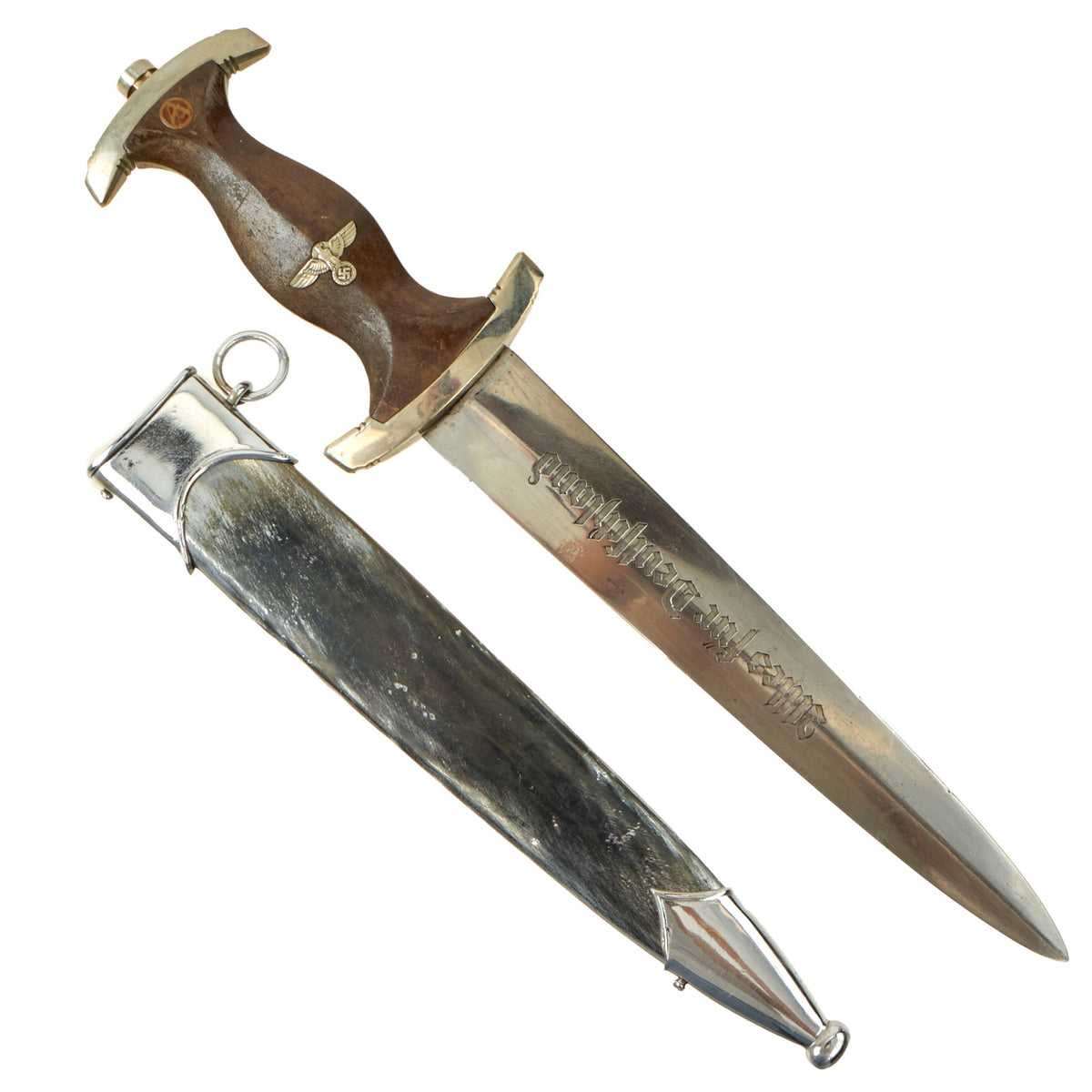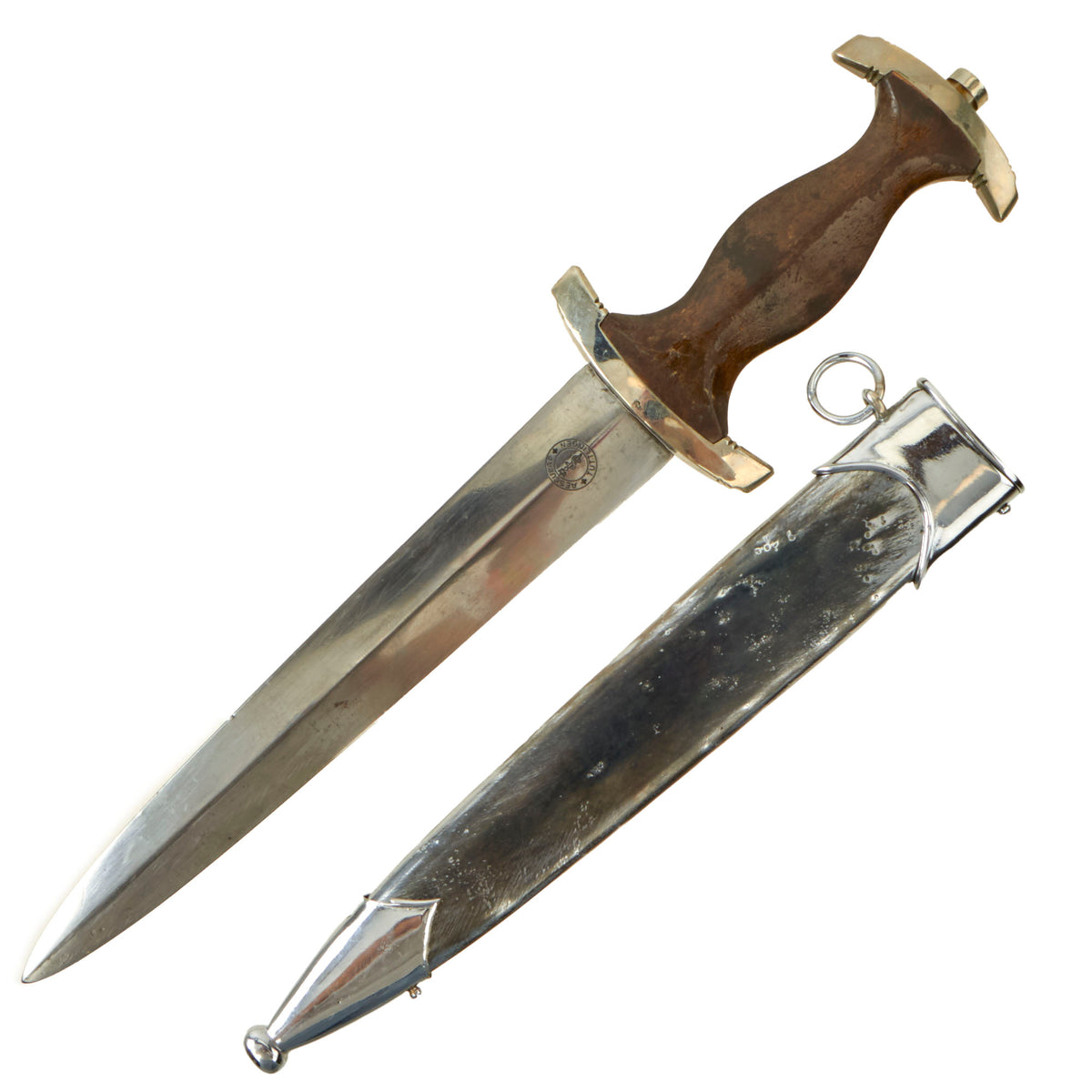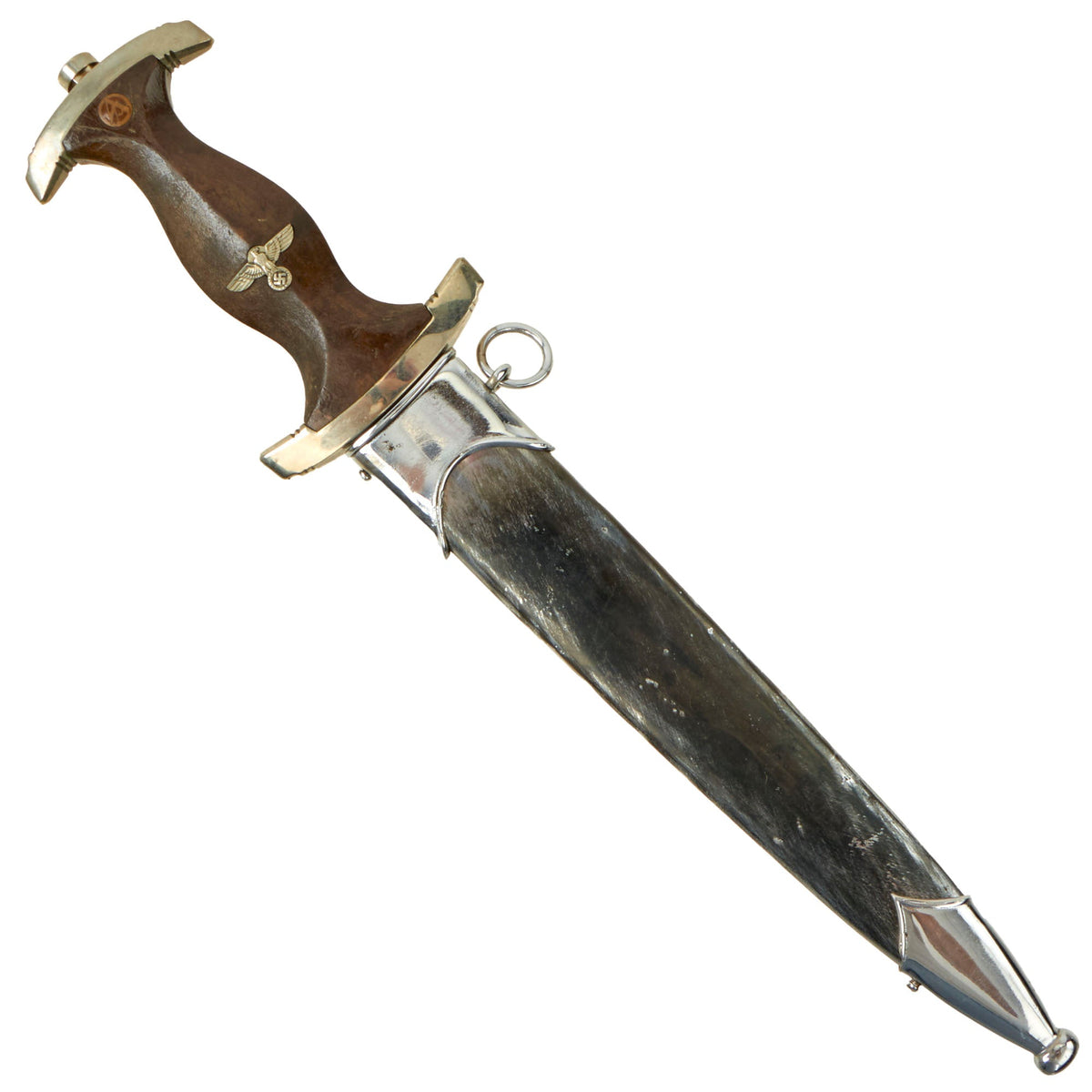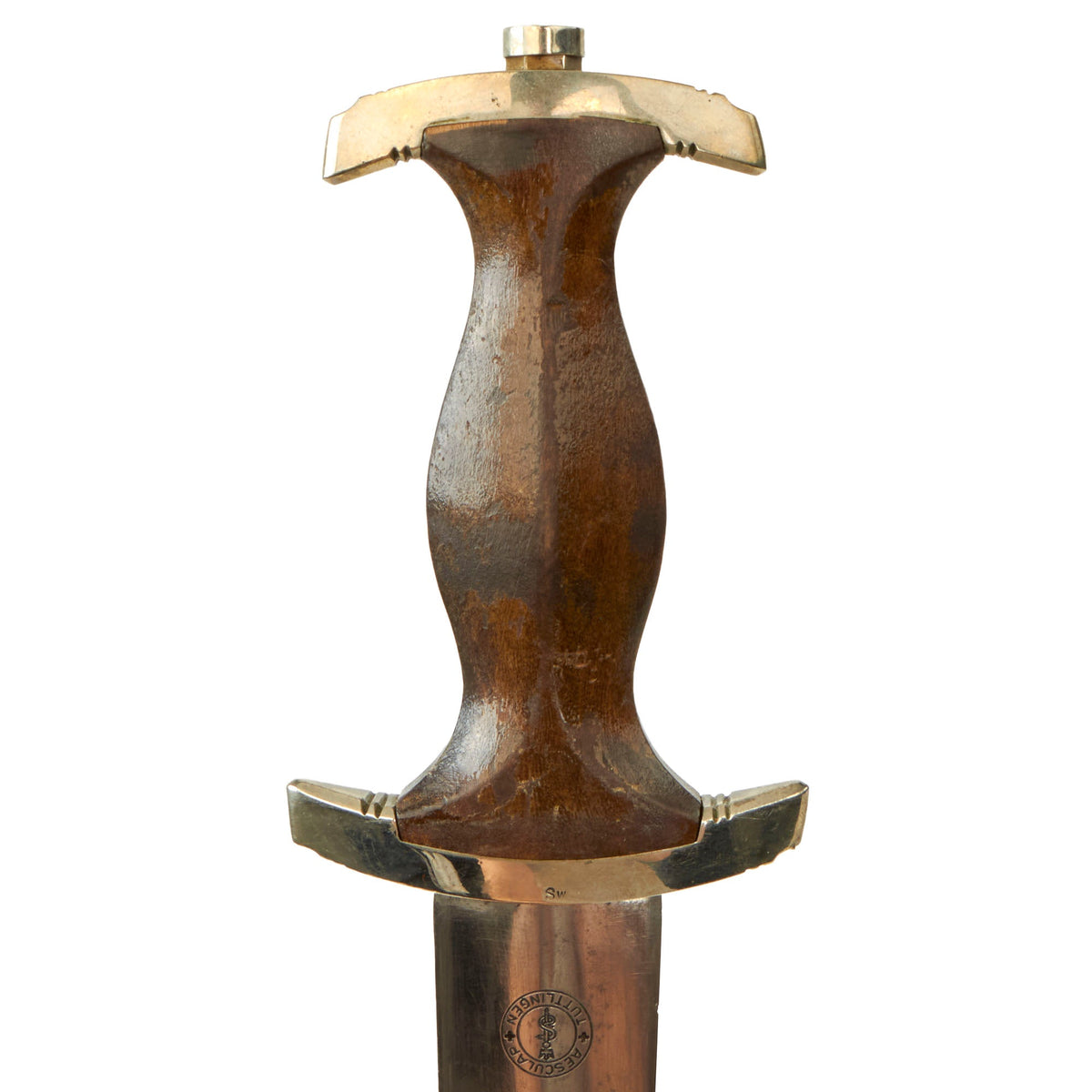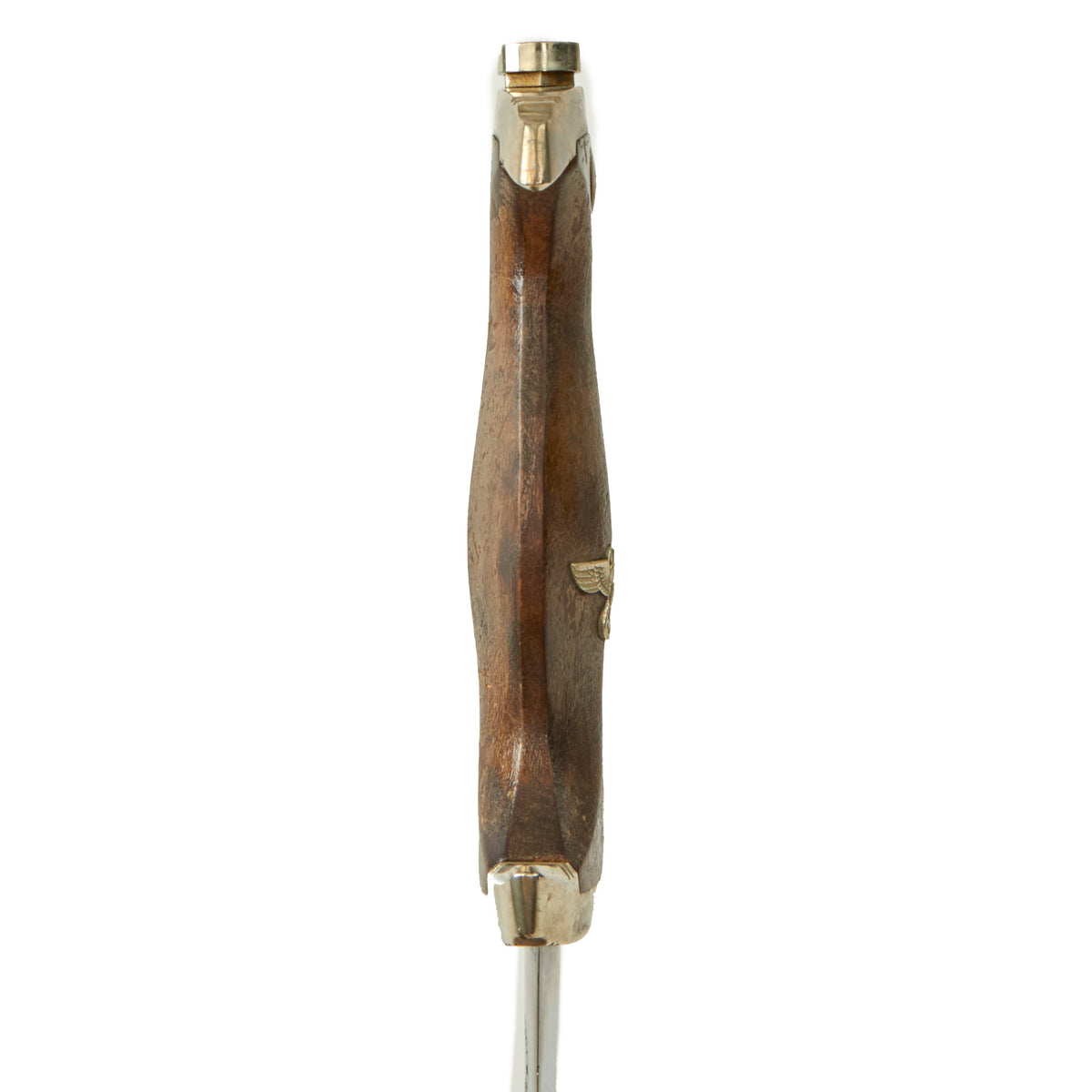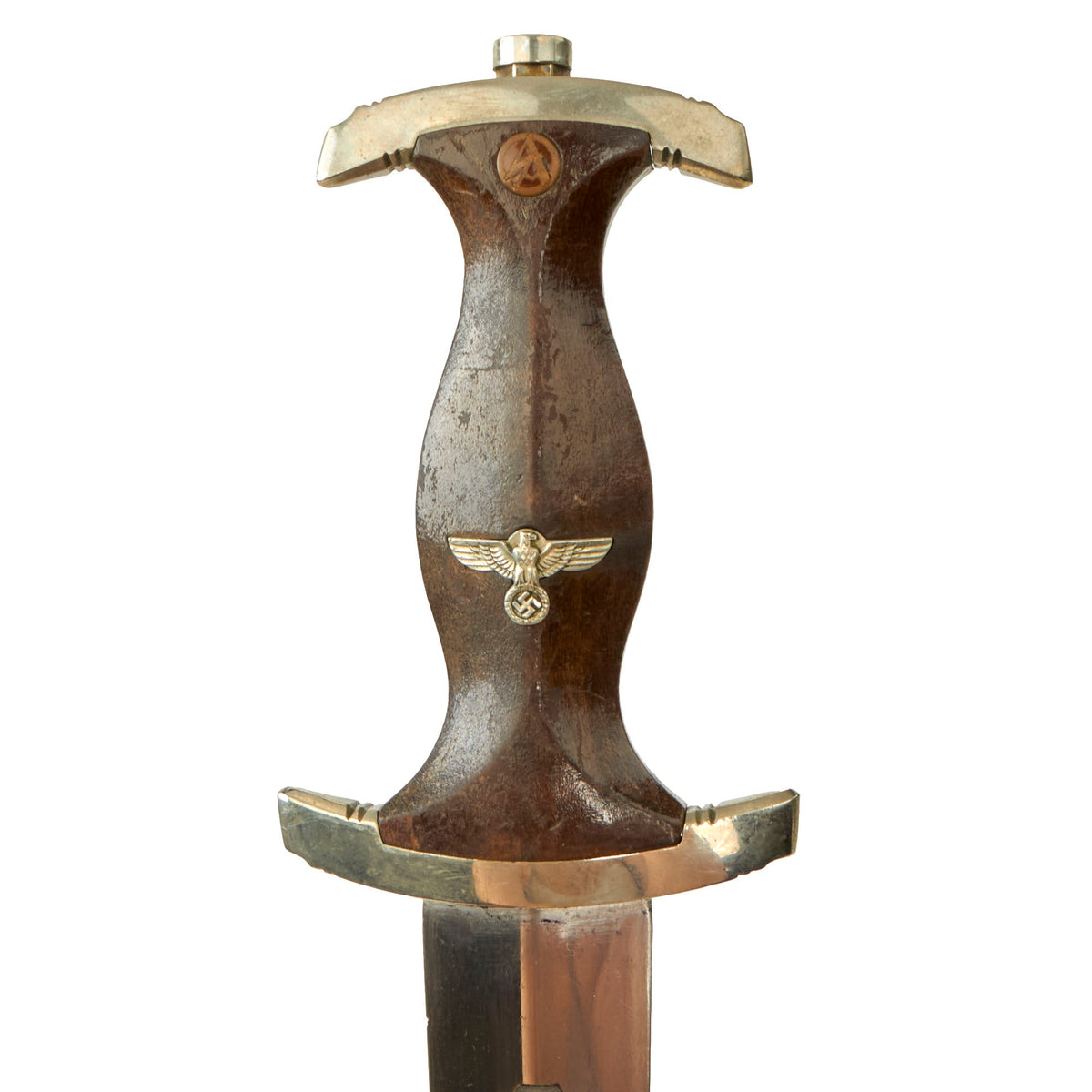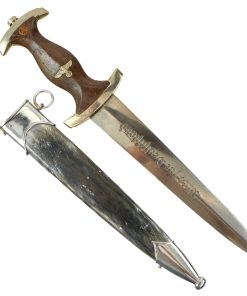Original German Early WWII NSKK Dagger by AESCULAP of Tuttlingen with Scabbard Original Items
$ 795,00 $ 238,50
Original Item: Only One Available. This is a very nice early pattern NSKK Dagger, made by the rare maker Aesculap-Werke AG of Tuttlingen, a company much more known for their surgical instruments than their blades. They only made these daggers for a short period of time, as the company was much more needed for its ability to make surgical instruments during the war, a business they continue to excel in. The dagger complete with an original later war scabbard, which looks to have had the body polished to remove oxidation, and then had some black oxide applied. It is possible that this was originally an SA dagger, which are identical to the NSKK dagger except for the finish color on the scabbard.
The dagger has solid nickel silver fittings throughout, and is a really nice example. The cross guards and tang nut are in very good condition throughout with all fittings having a nice lightly aged patina. The lower reverse guard is Gruppe/Gau marked Sw ,for Sudwest (South West) a district in far South West Germany, with the principal city being Stuttgart. This feature was only seen on daggers produced 1935 and prior. The nickel alloy pommel nut is in great shape, with no signs of turning.
The grip is a fine product having a nice chocolate brown color, with a medium center ridge construction. This color seems to be unique to Aesculap, as other examples we have seen had this same grip color. It looks to have had some type of varnish or lacquer applied at some point, which has partly flaked away and discolored. There are some scratches and tiny dents, but no cracks or chunks missing. It fits the crossguards nicely, with no wobble we can feel. The symbol button is nicely set, and still has about 75% of the enamel intact, however the plating is completely worn away. The grip eagle is a fine example being the style with beak that points straight. Most of the details are still there to the eagle to include the beak, breast feathering, wing feathering, talons, wreath and mobile swas. There is a bit of wear, showing that is the correct solid nickel silver for an early pattern eagle.
The blade of this example is in very good condition, bright and shiny, though it does look like it was polished post manufacture to remove staining and oxidation. This has unfortunately removed the original factory final polish grind cross grain from most of the blade, with remnants visible near the cross guard. This texture is iconic, and is the definitive identifying characteristic for a real WWII German Blade. There are some nicks on the edge of the blade, but it does not look like it was sharpened. The acid-etched Alles für Deutschland (Everything for Germany) SA motto is still clear, though cleaning has removed all of the factory darkening, and the edges are a bit rounded.
The rear of the blade bears the deeply etched trademark logo of Aesculap-Werke AG of Tuttlingen in Württemberg, a company that still exists today as a major maker of surgical instruments. Their logo is the well-known “S-form” serpent coiled around a ball-headed staff, the “Rod of Aesculapius”, the Greek God of medicine, under a crown. This trademark is on the back of the blade, surrounded by:
AESCULAP
(CROWN)
+ (Rod of Aesculapius) +
TUTTLINGEN
Per J. Anthony Carter’s book GERMAN KNIFE AND SWORD MAKERS,this firm was originally founded by Gottfried Jetter in 1867, and in 1887 he partnered with the Scheerer brothers to form Jetter & Scheerer. By 1895, they recognized the limitations of a family business, and formally incorporated. They built a new factory and registered the trademark Aesculap. The company used this particular “round” trademark on very early SA and NSKK daggers, which they made only made a small number of. They were a known maker of early Ernst Röhm signed daggers, however this example shows no evidence of ever having the signature.
The scabbard on this example has been replaced with a mid-late war pattern example, probably when the original was lost or damaged. The steel body is straight and dent free, but lost the paint and suffered oxidation. It was later removed from the fittings and buffed to bright steel, and then had a blacked finish applied, after which the nickel plated steel fittings were replaced. These are in very good shape, though each only has one of the securing screws still present.
A very nice early war SA dagger by a very rare and desirable maker, complete scabbard. Ready to display!
Specifications:
Blade Length: 8 3/4″
Overall length: 13 3/4”
Crossguard: 3”
Scabbard Length: 10”
History of the SA & NSKK-
The SA or Brown Shirts, were a private political formation which Adolf AH and the NSDAP used to maintain order at organized Party meetings and demonstrations. The group was formed in 1921, and grew to a huge force of nearly 3,000,000 men by the later 1930’s. To instill esprit de corps, as well as create employment for the Blade City of Solingen, it was decided each SA man would carry a dagger with his Brown Shirt uniform. Huge quantities needed to be produced to accommodate the demand. The dagger initially was produced of hand-fitted nickel mounts with attractive finished wood grip and brown anodized (a bluing process) finished scabbard.
The blade was etched with the SA motto, Alles für Deutschland. Examples produced prior to 1935 were stamped with the German sector of the SA group on reverse lower crossguard. Later examples underwent standardization through the RZM ministry. These pieces were produced of cheaper plated zinc-base fittings and scabbards were simply painted brown.
Prior to his “unmasking” as a traitor, Ernst Röhm was the leader of the SA. In 1934, he distributed approximately 100,000 SA daggers with his personal inscription on the reverse blade. These daggers were to honor individuals who had served with the SA prior to December, 1931. Other than the inscription, these pieces were identical to the standard M1933 SA dagger. After the Röhm purge, the inscription was ordered to be removed. Many examples were returned to the factory for grinding. Others were simply ground in the field by whatever means were available. Examples will occasionally be encountered with remnants of the original inscription remaining on the blade, but mostly none will remain. Some blades exist with an intact inscription, reflecting only the removal of the Röhm signature. Very very rarely is an example seen with a full, untouched inscription, as the holder would have surely risked a charge of treason.
After the purge, the NSKK, which had been a part of the SA, was split off into a separate organization. They retained the same daggers as the SA, however now used a black painted scabbard, and their officer’s daggers had a few differences as well. Many already had SA daggers, so these had the scabbards painted black over the original brown anodized finish.
Fast Shipping with Professional Packaging
Thanks to our longstanding association with UPS FedEx DHL, and other major international carriers, we are able to provide a range of shipping options. Our warehouse staff is expertly trained and will wrap your products according to our exact and precise specifications. Prior to shipping, your goods will be thoroughly examined and securely secured. We ship to thousands clients each day across multiple countries. This shows how we're dedicated to be the largest retailer on the internet. Warehouses and distribution centres can be located throughout Europe as well as the USA.
Note: Orders with more than one item will be assigned a processing date depending on the item.
Before shipping before shipping, we'll conduct a thorough inspection of the items you have ordered. Today, the majority of orders will be delivered within 48 hours. The delivery time will be between 3-7 days.
Returns
The stock is dynamic and we cannot completely manage it because multiple stakeholders are involved, including our factory and warehouse. So the actual stock may alter at any time. It's possible that you may not receive your order once the order has been made.
Our policy is valid for a period of 30 days. If you don't receive the product within 30 days, we are not able to issue a refund or an exchange.
You can only return an item if it is unused and in the same state as the day you received it. You must have the item in its original packaging.
Related products
Uncategorized
Uncategorized
Uncategorized
Uncategorized
Uncategorized
Uncategorized
Uncategorized
Uncategorized
Uncategorized
Uncategorized
Angolan Rebel 1970s era 60mm Inert Display Mortar from Angolan Civil War Original Items
Uncategorized
Uncategorized
Uncategorized
Uncategorized
Uncategorized
Uncategorized
Uncategorized
Uncategorized
